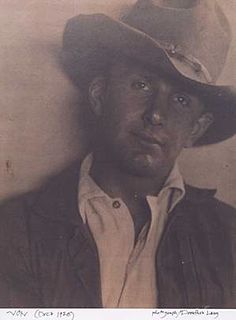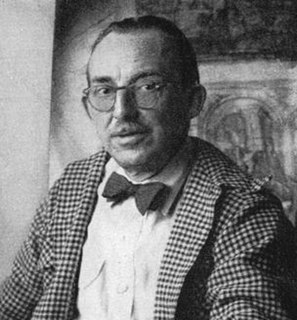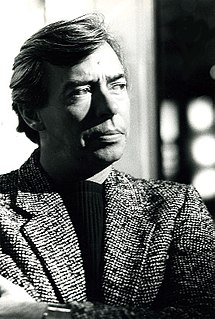
Newell Convers Wyeth, known as N. C. Wyeth, was an American artist and illustrator. He was the pupil of artist Howard Pyle and became one of America's greatest illustrators. During his lifetime, Wyeth created more than 3,000 paintings and illustrated 112 books — 25 of them for Scribner's, the Scribner Classics, which is the body of work for which he is best known. The first of these, Treasure Island, was one of his masterpieces and the proceeds paid for his studio. Wyeth was a realist painter at a time when the camera and photography began to compete with his craft. Sometimes seen as melodramatic, his illustrations were designed to be understood quickly. Wyeth, who was both a painter and an illustrator, understood the difference, and said in 1908, "Painting and illustration cannot be mixed—one cannot merge from one into the other."
Bernie Fuchs was an American illustrator known for advertising art, magazine illustration and portraiture, including for a series of U.S. postage stamps.
Mark English was an American illustrator and painter, born in Hubbard, Texas. He was one of the United States' leading illustrators for publications in a career spanning from the 1960s to the 1990s, before beginning a career painting for gallery exhibition in 1995.

McClelland Barclay was an American illustrator. By the age of 21, Barclay's work had been published in The Saturday Evening Post, Ladies' Home Journal, and Cosmopolitan. He was commissioned as a lieutenant in the Naval Reserve in 1938 and following the Japanese attack on Pearl Harbor he went on active duty. At the time of his death, in 1943, he was a Lt. Commander.

Harrison Fisher was an American illustrator.

Chevalier Fortunino Matania was an Italian artist noted for his realistic portrayal of World War I trench warfare and of a wide range of historical subjects.

Harold von Schmidt was an American illustrator, who specialized in magazine interior illustrations.

Dean Cornwell was an American illustrator and muralist. His oil paintings were frequently featured in popular magazines and books as literary illustrations, advertisements, and posters promoting the war effort. Throughout the first half of the 20th century he was a dominant presence in American illustration. At the peak of his popularity he was nicknamed the "Dean of Illustrators".
Charles Joseph Santore was an American illustrator best known for his children's books. His work is on display permanently at the Brandywine River Museum of Art and the Museum of Modern Art. He won the Hamilton King award from the New York Society of Illustrators in 1972. His book William the Curious was honored in the 1998 Storytelling World 'Stories for Pre-Adolescent Listeners' category. His most popular works include his celebrity portraits for TV Guide. Santore died on August 11, 2019.
Arthur Sarnoff was an American artist. Prior to working as an illustrator, Sarnoff studied at the Industrial School and the Grand Central School of Art in New York City. He was a member of the Society of Illustrators and exhibited widely including the National Academy of Design.
Septimus Edwin Scott (1879–1965), who signed his name Sep E. Scott, was a British painter, illustrator and comics artist.

Bradshaw Crandell was an American artist and illustrator. He was known as the "artist of the stars". Among those who posed for Crandell were Carole Lombard, Bette Davis, Judy Garland, Veronica Lake and Lana Turner. In 1921 he began his career with an ad for Lorraine hair nets sold exclusively by F. W. Woolworth. His first cover illustration was the May 28, 1921 issue for the humor magazine Judge. In later life he went from illustrations to oil-on-canvas paintings which included political figures. He also provided poster work for 20th Century Fox. In 2006 he was inducted into the Society of Illustrators hall of fame. In March 2010, an illustration for the 1952 Dutch Treat Club yearbook of Crandell's sold for $17,000.
Philip R. Goodwin was an American painter and illustrator who specialized in depictions of wildlife, the outdoors, fishing, hunting and the Old American West. He provided illustrations for numerous books and magazines, as well as for commercial items, such as posters, advertisements and calendars. He is perhaps best known for illustrating Jack London's The Call of the Wild and for providing the cover art for many issues of Outdoor Recreation / Outdoor Life Magazine during the 1920s and early 1930s. He is also the artist who designed the Horse & Rider Trademark of the Winchester Repeating Arms Company. Goodwin was a very private person and did not seek publicity, so not much was known about his private life during his lifetime. Most of what is known comes from letters held at the Buffalo Bill Historical Center.

Lorraine Fox (1922–1976) was an American illustrator and commercial artist who illustrated magazines, book covers, and advertisements. Among the magazines she illustrated for were Woman's Day, Good Housekeeping, Redbook, McCall's, and Cosmopolitan. She was inducted into the Society of Illustrators' Hall of Fame in 1979.

Walter Martin Baumhofer was an American illustrator notable for his cover paintings seen on the pulp magazines of Street & Smith and other publishers.
Willard A. Downes (1908–2000) was an American artist and illustrator. He was artistically active his entire life as a painter and illustrator. He painted portraits, landscapes and did caricatures of famous people. He was the uncle of Doris Downes, an American botanical artist.
Douglass Crockwell, born Spencer Douglass Crockwell, was an American commercial artist and experimental filmmaker. He was most famous for his illustrations and advertisements for The Saturday Evening Post and for murals and posters for the Works Progress Administration.
Rafael de Penagos (1889–1954) was a Spanish illustrator and painter. He was a practitioner of the art deco style and considered one of the most representative figures of Madrilenian modernism.

Robert Heindel was an American painter, illustrator, and stage designer best known for his paintings of dance and performing arts. Heindel created over 1300 paintings and drawings of dance and performing arts during a twenty-five year period in the late twentieth century. He was described as the best painter of dance of his time.

John La Gatta, also spelled LaGatta, was an advertising illustrator active during the first half of the 20th century.













